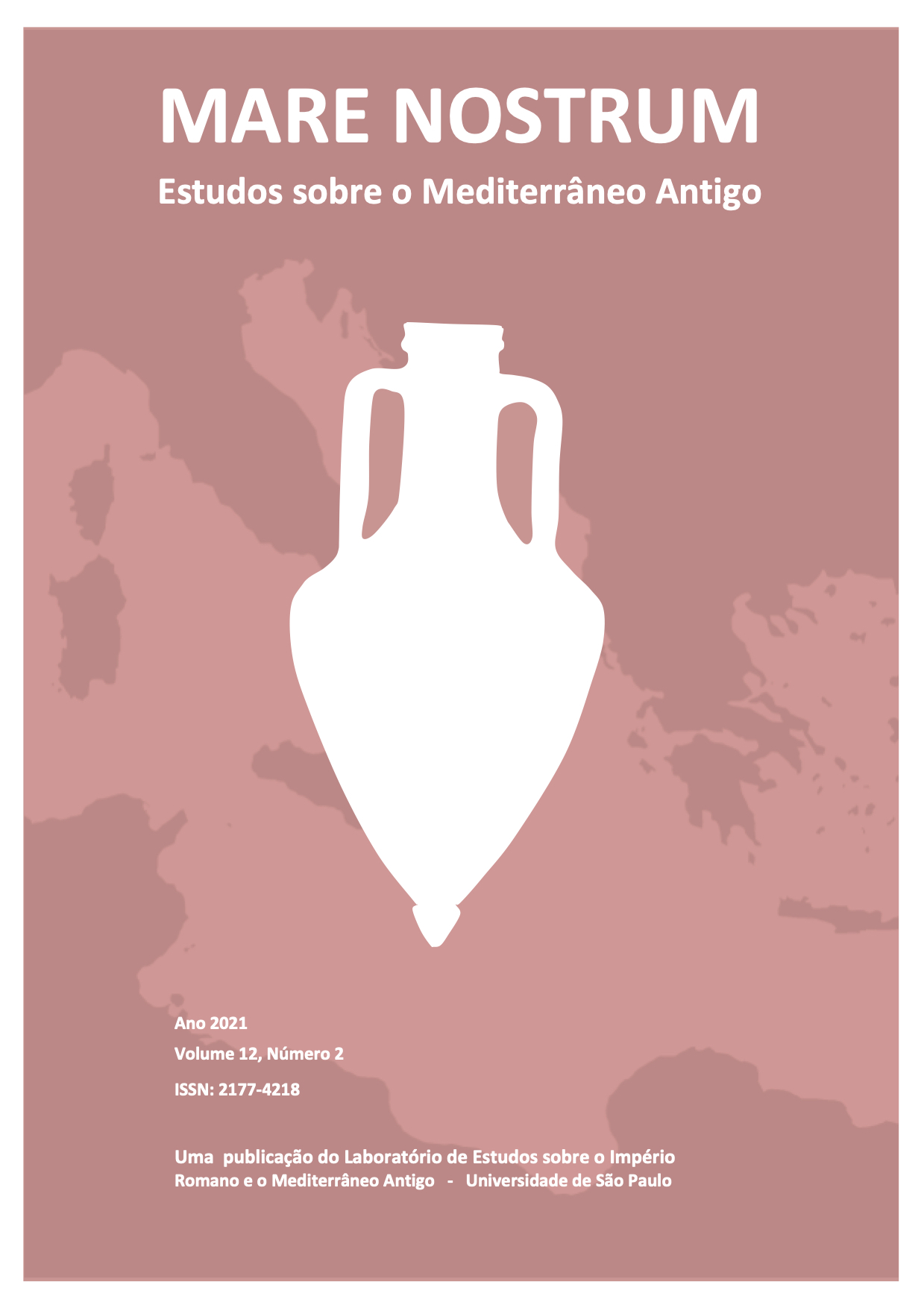Insularity and Imperial Politics: Hadrian on the Greek Islands
DOI:
https://doi.org/10.11606/issn.2177-4218.v12i2p199-221Palavras-chave:
Roman Greece, Hadrian, Insularity, Roman Imperialism, Aegean IslandsResumo
Since its conquest by Rome in the 2nd century BCE, Roman notables were a constant presence in Greece. While various sites on the mainland served as battlegrounds for Roman civil wars during the 1st century BCE (e.g., Pharsalus, Actium, Philippi), the early imperial period was characterized by the use of various Greek islands as places of – often self-imposed – exile and/or isolation for such notables as M. Vipsanius Agrippa (Lesbos) and Tiberius (Rhodes). Other imperial Romans sojourned in the Aegean islands for different reasons. Augustus spent a winter on Samos after his victory at Actium, using it as a temporary powerbase for the refinement of his imperial plans, and he visited it and other islands again as emperor. While the first two Julio-Claudian emperors maintained close contacts with the Greek world, in the 2nd century CE Hadrian took this connection a step further and promoted Hellenism as a major part of his imperial policy. Naturally, the Greek islands played an important role in imperial politics during his reign, but only as components of the wider Hellenic world and not as isolated entities. Hadrian visited Rhodes and Paros to restore and venerate older Hellenic monuments – the Colossus and the tomb of the poet Archilochus respectively – and possibly Samothrace in order to be initiated into the Mysteries of the Great Gods. He also visited other islands in Greece, but his exact travel itinerary can only be speculative given our fragmentary literary and epigraphic evidence. In this paper, I focus on Hadrian’s presence on the Aegean islands and argue that during his reign they served mainly as sites that allowed for the implementation of his imperial plans by virtue of their easy access from the mainland Greek and Asian provinces. Accordingly, by promoting certain aspects of older Hellenic culture on specific islands, Hadrian conferred renewed prestige to these islands in the Roman Empire.
Downloads
Referências
Ager, S. L. (1991). Rhodes: the rise and fall of a neutral diplomat. Historia: Zeitschrift für Alte Geschichte, (H. 1), 10-41.
Ashton, R. H. J. (2001). The coinage of Rhodes 408-190 BC. In A. Meadows and K. Shipton (Eds.) Money and its uses in the ancient Greek world. Oxford: Oxford University Press, 79-115.
Ashton, R. (1988). Rhodian coinage and the Colossus. Revue numismatique, 6(30), 75-90.
Bellemore, J. (2007). Tiberius and Rhodes. Klio, 89(2), 417-453.
Birley, A. (1997). Hadrian: The Restless Emperor. London: Routledge.
Boatwright, M.T. (2000). Hadrian and the Cities of the Roman Empire. Princeton: Princeton University Press.
Bowersock, G. W. (1964). Augustus on Aegina. The Classical Quarterly, 14(1), 120-121.
Bowie, E. L. (2002). Hadrian and Greek poetry. In E.N. Ostenfeld (Ed.) Greek Romans and Roman Greeks: Studies in Cultural Interaction. Aarhus: Aarhus University Press, 172-197.
Bowie, E. L. (1997). Hadrian, Favorinus, and Plutarch. In J. Mossman (Ed.) Plutarch and his Intellectual World. London: The Classical Press of Wales, 1-15.
Bradford, A. (1986). The Date Hadrian was Eponymous Patronomos of Sparta. Horos 4, 71-74.
Braginton, M. V. (1944). Exile under the Roman emperors. The Classical Journal, 39(7), 391-407.
Brennan, T. C. (1998). The poets Julia Balbilla and Damo at the colossus of Memnon. The Classical World, 91(4), 215-234.
Camia, F. (2022). Hadrianos Olympios Panhellenios: Worshipping Hadrian in Roman Athens. In A. Kouremenos (Ed.). The Province of Achaea in the 2nd Century CE: The Past Present. London and New York: Routledge, 93-116.
Cartledge, P. and A.J.S Spawforth (2002). Hellenistic and Roman Sparta. A Tale of Two Cities. London and New York: Routledge.
Cole, S. G. (1984). Greek Initiates And Theoroi At Samothrace. In Theoi Megaloi: The Cult of the Great Gods at Samothrace. Leiden: Brill, 38-56.
Collart, P. (1932). Favorinus d'Arles. Bulletin de l'Association Guillaume Budé, 34(1), 23-31.
Conrad, L. I. (1996). The Arabs and the Colossus. Journal of the Royal Asiatic Society, 6(2), 165–187.
D’Ambrosi, D. T. (2020). Les Voyages d’Hadrien: Sur les traces de l'empereur nomade. Paris: Arkhê Editions.
De Callatay, G. (2006). The Colossus of Rhodes: Ancient Texts and Modern Representations. In C. Ligota and J.L. Quantin (Eds.), History of Scholarship: A Selection of Papers from the Seminar on the History of Scholarship Held Annually at the Warburg Institute. Oxford: Oxford University Press, 39-74.
D’ Hautcourt, A. (1995). L'exil de Cassius Severus: hypothèse nouvelle. Latomus, 54 (Fasc. 2), 315-318.
Dimitrova, N. M. (2008). Theoroi and initiates in Samothrace: the epigraphical evidence (Vol. 37). Hesperia Supplement, 37. Princeton: American School of Classical Studies at Athens.
Dürr, J. (1881). Die Reisen des Kaisers Hadrian. Vienna: C. Gerold's Sohn.
Enos, R. L. (2004). The art of rhetoric at Rhodes: an eastern rival to the Athenian representation of Classical rhetoric. In C.S. Lipson and R.A. Binkley (Eds.) Rhetoric Before and Beyond the Greeks. Albany, 183-96.
Erskine, A. (1991). Rhodes and Augustus. Zeitschrift für Papyrologie und Epigraphik, 271-275.
Evans, S. H., A.C. Grayling, T. Holland, and L. Xinran. (2015). On forgotten free-speech heroes. Index on Censorship, 44(2), 87-90.
Francis, J. and A. Kouremenos (Eds.) (2016). Roman Crete: New Perspectives. Oxford: Oxbow.
Galimberti, A. (2010). Hadrian, Eleusis, and the beginning of Christian apologetics. In M. Rizzi (Ed.) Hadrian and the Christians. New York: Walter de Gruyter, 71-84.
Gergel, R. A. (2004). Agora S166 and related works: the iconography, typology, and interpretation of the Eastern Hadrianic breastplate type. Hesperia Supplements, 33, 371-409.
Gleason, M. W. (1994). Making Men: Sophists and Self-Representation in Ancient Rome. Princeton: Princeton University Press.
Greenwalt, W. S. (2009). Philip and Olympias on Samothrace. Macedonian Legacies: Papers on Macedonian Culture and History in Honor of Eugene N. Borza. Claremont, Calif, 79-106.
Grigoropoulos, D. (2015). Hadrian, Abai and the Memory of the Persian Wars. In D. Panagiotopoulos, I. Kaiser, and O. Kouka (Eds.) Ein Minoer im Exil. Festschrift für Wolf-Dietrich Niemeier. Bonn: Dr Rudolf Habelt Verlag GmbH, 75-98.
Gruen, E. S. (1975). Rome and Rhodes in the Second Century BC: A Historiographical Inquiry. The Classical Quarterly, 25(1), 58–81.
Halfmann, H. (1986). Itinera principum: Geschichte und Typologie der Kaiserreisen im Römischen Reich. Stuttgart: F. Steiner Verlag.
Haynes, D.L.A (1957). Philo of Byzantium and the Colossus of Rhodes. JHS 77, 311-12.
Hawkins, T. (2014). Iambic Poetics in the Roman Empire. Cambridge: Cambridge University Press.
Højte, J. M. (2000). Imperial Visits as Occasion for the Erection of Portrait Statues?. Zeitschrift für Papyrologie und Epigraphik, 221-235.
Isager, J. (Ed.) (2001). Foundation and Destruction: Nikopolis and Northwestern Greece. Aarhus: Aarhus University Press.
Jones, C. P. (2011). An edict of Hadrian from Maroneia. Chiron, 41, 313-326.
Kennell, N. (2022). Memory and identity among the ephebes of 2nd-century Achaea. In A. Kouremenos (Ed.) The Province of Achaea in the 2nd Century CE: The Past Present. London and New York: Routledge, 13-34.
Kapetanopoulos, E. (1992-1998). The Reform of the Athenian Constitution under Hadrian. Horos 10-12, 215-237.
Karanastasi, P. (2016). Roman Imperial Sculpture from Crete: A Reappraisal. In J. Francis and A. Kouremenos (Eds.) Roman Crete: New Perspectives. Oxford: Oxbow, 101-118.
Karanastasi, P. (2012). Hadrian im Panzer: Kaiserstatuen zwischen Realpolitik und Philhellenismus. Jahrbuch des Deutschen Archäologischen Instituts, 127, 323-391.
Kebric, R. B. (2019). The Colossus of Rhodes: Its Height and Pedestal. Athens Journal of Humanities and Arts, 259-298.
Kirsten, E. (1987) The origins of the first inhabitants of Nikopolis. In E. Chrysos (Ed.) Nicopolis I: Proceedings of the First International Symposium on Nicopolis (23-29 September 1984). Preveza, 91-98.
Kouremenos, A. (forthcoming). The Roman Past of Greece. London and New York: Routledge.
Kouremenos, A. (Ed.) (2022). The Province of Achaea in the 2nd Century CE: The Past Present. London and New York: Routledge.
Lagogianni-Georgakarakos, M. and E. Papi (2018). HADRIANVS-ΑΔΡΙΑΝΟΣ: Ο Αδριανός, η Αθήνα και τα Γυμνάσια-Adriano, Atene ei Ginnasi-Hadrian, Athens and the Gymnasia [exhibition catalogue]. SAIA: Scuola Archeologica di Atene.
Le Quéré, E. (2018). Was Delos Really Adelos? A Reappraisal of the Delian Solitude in Roman Imperial Times. In V. Di Napoli, F. Camia, V. Evangelidis, D. Grigoropoulos, D. Rogers, and S. Vlizos (Eds.) What’s New in Roman Greece? Recent Work on the Greek Mainland and the Islands in the Roman Period. Athens: Meletemata 80, 111-121.
Levick, B. M. (1972). Tiberius' Retirement to Rhodes in 6 BC. Latomus, 31(Fasc. 3), 779-813.
Magie, D. (1908). The Mission of Agrippa to the Orient in 23 BC. Classical Philology, 3(2), 145-152.
Maryon, H. (1956). The Colossus of Rhodes. The Journal of Hellenic Studies, 76, 68-86.
Morgan, G. (2006). 69 AD: the year of four emperors. Oxford: Oxford University Press.
Oliver, J. H. (1950). Hadrian's Precedent, the Alleged Initiation of Philip II. The American Journal of Philology, 71(3), 295-299.
Purcell, N. (1987). The Nicopolitan synoecism and Roman urban policy. In E. Chrysos (Ed.) Nicopolis I: Proceedings of the First International Symposium on Nicopolis (23-29 September 1984). Preveza, 71-90.
Roddaz, J. M. (2005). Culte impérial et fidélité dynastique: Agrippa et l'île de Lesbos. Studia historica. Historia antigua, (23), 401-412.
Rudich, V. (2006). Navigating the uncertain: Literature and censorship in the early Roman Empire. Arion: A Journal of Humanities and the Classics, 14(1), 7-28.
Rutledge, S. H. (2008). Tiberius' philhellenism. Classical World, 453-467.
Schmalz, G. C. (1996). Athens, Augustus, and the Settlement of 21 BC. Greek, Roman, and Byzantine Studies, 37(4), 381-398.
Schockmel, B. (2012). The Sanctuary of the Great Gods at Samothrace: Hellenistic Patronage and Politics. Art History Honors Projects. 6.
Seager, R. (1972). Tiberius. Berkeley: University of California Press.
Seebacher, C. (2020). Zwischen Augustus und Antinoos. Tradition und Innovation im Prinzipat Hadrians (Studies in Ancient Monarchies, Vol. 6.) Stuttgart: Steiner Verlag.
Spawforth, A. J. (2011). Greece and the Augustan cultural revolution. Cambridge: Cambridge University Press.
Steinhauer, G., and S.A. Paspalas (2006). The Euryklids And Kythera. Mediterranean Archaeology, 19/20, 199–206.
Swain, S., and K. van Bladel (2008). Seeing the Face, Seeing the Soul: Polemon’s Physiognomy from Classical Antiquity to Medieval Islam. Aestimatio: Critical Reviews in the History of Science, 5, 225-233.
Swain, S. (1989). Favorinus and Hadrian. Zeitschrift Für Papyrologie Und Epigraphik, 79, 150-158.
Sweetman, R. J. (2016). Networks: exile and tourism in the Roman Cyclades . in J. F. D. Frakes M. Egri, and S. E. Alcock (Eds.) Beyond Boundaries: Connecting Visual Cultures in the Provinces of Ancient Rome. Los Angeles: Getty Publications, 46-61.
Van Nijf, O. and Meijer, F. (1992). Trade, Transport and Society in the Ancient World. London: Routledge.
Weller, J. A. (1958). Tacitus and Tiberius' Rhodian Exile. Phoenix, 12(1), 31-35.
Yorke, V. W. (1896). Excavations at Abae and Hyampolis in Phocis. The Journal of Hellenic Studies, 16, 291-312.
Zoumbaki, S. (2018). Where East Meets West: Island Societies of the Ionian Sea Under Roman Rule. In A. Kouremenos (Ed.) Insularity and Identity in the Roman Mediterranean. Oxford: Oxbow, 77-106.
Downloads
Publicado
Edição
Seção
Licença
Copyright (c) 2021 Anna Kouremenos

Este trabalho está licenciado sob uma licença Creative Commons Attribution 4.0 International License.
Os conteúdos expressos nos textos publicados pela Mare Nostrum são de exclusiva responsabilidade de seus respectivos autores.
A reprodução dos textos editados pela Mare Nostrum é permitida sob licença Creative Commons, Atribuição-NãoComercial (CC BY-NC).
Autores que publicam nesta revista concordam com os seguintes termos:
- Autores mantém os direitos autorais e concedem à revista o direito de primeira publicação, com o trabalho simultaneamente licenciado sob a Licença Creative Commons Attribution que permite o compartilhamento do trabalho com reconhecimento da autoria e publicação inicial nesta revista.
- Autores têm autorização para assumir contratos adicionais separadamente, para distribuição não-exclusiva da versão do trabalho publicada nesta revista (ex.: publicar em repositório institucional ou como capítulo de livro), com reconhecimento de autoria e publicação inicial nesta revista.
- Autores têm permissão e são estimulados a publicar e distribuir seu trabalho online (ex.: em repositórios institucionais ou na sua página pessoal) a qualquer ponto antes ou durante o processo editorial, já que isso pode gerar alterações produtivas, bem como aumentar o impacto e a citação do trabalho publicado (Veja O Efeito do Acesso Livre).









